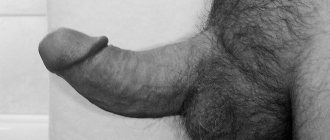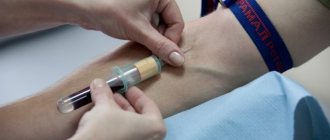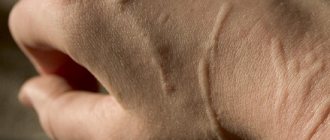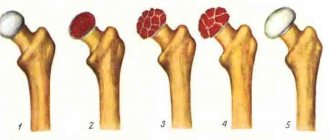The thyroid gland is an endocrine organ, consisting of two lobes connected by an isthmus, located in the lower part of the anterior surface of the neck at the level of the cricoid cartilage
In recent years, there has been a steady increase in thyroid diseases throughout the world, including such diseases as diffuse toxic goiter (Graves' disease, Graves' disease).
Classification and severity of diffuse toxic goiter
Clinical guidelines for the diagnosis, treatment and prevention of Graves' disease offer several options for its classification:
- according to O. V. Nikolaev;
- recommended by the World Health Organization (WHO);
- according to the severity of thyrotoxicosis - options I and II.
Classification of Graves' disease according to O. V. Nikolaev
| Degree | Characteristic |
| 0 | The thyroid gland is not detectable on palpation |
| I | On palpation, an enlarged isthmus of the thyroid gland is felt |
| II | Enlargement of the lateral lobes of the gland, determined by palpation |
| III | Visual enlargement of the thyroid gland – “thick neck” |
| IV | Clearly visible goiter (significant enlargement of the gland) |
| V | Huge size goiter |
This classification has advantages over the one proposed by WHO, since it contains more degrees of gradation of the disease, which allows clinicians to apply more precise treatment prescriptions at each stage.
WHO recommended classification
| Degree | Characteristic |
| 0 | There is no goiter, the volume of each lobe of the thyroid gland is no more than the volume of the distal phalanx of the patient’s thumb |
| I | The goiter is not determined visually, but can be felt by palpation. There may be nodes that do not increase the volume of the gland |
| II | Clearly visible goiter with normal neck position |
Classification according to the severity of thyrotoxicosis: option I
Depending on the extent of damage to the thyroid gland and the existing symptoms, there are three degrees of severity of the disease:
- mild - decreased performance, tachycardia - increased heart rate (HR) up to 100 beats per minute (bpm), decreased body weight by 10-15%;
- medium – characterized by high nervous excitability, heart rate reaches 100-120 beats per minute, weight loss exceeds 20%;
- severe - tachycardia over 120 beats/min, weight loss may exceed more than half of the initial body weight, severe complications appear, leading to complete loss of ability to work.
Classification according to the severity of thyrotoxicosis: option II
Proposed in 2007 by V.V. Fadeev and G.A. Melnichenko. Like option I, it is based on the severity of clinical manifestations and hormonal disorders. Takes into account the content of thyroid hormones in the blood.
Subclinical thyrotoxicosis (mild degree). It is characterized by the absence of clinical symptoms or their erased manifestations. The content of thyroid-stimulating hormone (TSH) is reduced, the content of free (free) T4 and free (free) T3 is within normal limits.
Manifest thyrotoxicosis (moderate). It is described by a developed clinical picture, a significantly reduced TSH content, an increased concentration of St. T4 and St. T3.
Complicated thyrotoxicosis (severe). Severe combined symptoms, psychotic phenomena, sharp loss of body weight. The TSH content is significantly lower than normal, the concentration of St. T4 and T3 are elevated.
Treatment of diffuse toxic goiter
There are many ways to treat Graves' disease, and the specific method is selected depending on the clinical situation. The methods are:
- conservative treatment;
- surgery;
- use of radioactive iodine;
- computer reflexology.
Each of these methods has its pros and cons, indications and contraindications. The attending physician decides which method to use, depending on the patient’s general condition, length of illness, presence or absence of complications, age and gender, and the presence of concomitant diseases.
Causes of Graves' disease
Graves' disease is an autoimmune disease . In this condition, autoimmune aggression occurs - the immune system, under the influence of certain factors, begins to produce antibodies that act on target organs. First of all, this is the thyroid gland, which in response begins to produce hormones in the wrong way.
The main cause of DTD is genetic predisposition. In most cases, it is ethnically associated - the haplotypes responsible for the development of the disease are found in people of the European race.
Despite the fact that the characteristics of the immune response can be inherited, they are not always realized. Provoking factors may be excess iodine, stress, smoking, bacterial or viral infections. Stress factors play a special role in triggering the mechanisms of the disease; smoking increases the risk of developing Graves' disease by 1.9 times. Some scientific studies put forward a theory about the molecular mimicry (similarity) of thyroid antigens with the antigens of some bacteria. Source: About Graves' or Graves' disease. Botkin S.P. Endocrinology: News. Opinions. Training, 2013. p. 25-36.
Diffuse toxic goiter can occur against the background of other autoimmune pathologies of the endocrine system - type I diabetes mellitus, primary hypocortisolism.
Symptoms of the disease
The symptoms of thyroid disease are caused by increased production of thyroid hormones, which affect almost the entire human body. The main signs of Graves' disease are symptoms of thyrotoxicosis, which can be divided into groups depending on which system they affect. Source: Morphological criteria for the diagnosis of diffuse toxic goiter. Botasheva V.S., Elkanova A.B., Lavrinenko A.A. Medical and pharmaceutical journal “Pulse”, 2021. p. 6-11.
Symptoms from the central and peripheral nervous system:
- irritability, excitability, fussiness, tearfulness, sleep disturbances;
- Marie's symptom - tremor (shaking) of outstretched fingers;
- “telegraph pole” symptom – tremor of the whole body;
- increased tendon reflexes;
- sometimes – the development of thyrotoxic psychosis.
Symptoms of damage to the cardiovascular system:
- sinus tachycardia, increased heart rate;
- increased systolic (upper) blood pressure and decreased diastolic (lower);
- increased pulse pressure (difference between systolic and diastolic);
- in severe cases of the disease - atrial fibrillation or its paroxysms;
- myocardial dystrophy, the occurrence of circulatory failure.
Symptoms that appear when the gastrointestinal tract is damaged:
- increased appetite;
- frequent loose stools;
- liver dysfunction up to thyrotoxic hepatosis.
Symptoms of damage to other endocrine glands:
- ovarian dysfunction, menstrual irregularities, decreased libido in women;
- gynecomastia and potency disorders in men;
- relative adrenal insufficiency;
- impaired glucose tolerance, causing type II diabetes mellitus.
Ectodermal disorder syndrome:
- brittle nails;
- splitting and hair loss;
- itchy skin, hot, moist to the touch skin;
- appearance of vitiligo.
Hypermetabolism (accelerated metabolism):
- progressive weight loss due to increased appetite;
- feeling of heat, low-grade body temperature;
- myasthenia gravis (muscle weakness), adynamia;
- osteoporosis.
The presence of a goiter is an important sign of Graves' disease, which is present in almost all patients, but the severity of this symptom varies, and the severity of the disease does not depend on the size of the goiter.
Endocrine ophthalmopathy (EOP) is another sign of DTZ. In most cases, it appears about a year later than thyrotoxicosis syndrome and has varying degrees of severity.
EOP symptoms:
- exophthalmos (bulging eyes), often asymmetrical;
- sparkle of eyes;
- rare blinking;
- photophobia, lacrimation, pain and burning in the eyes;
- swelling and pigmentation of the eyelids;
- diplopia (doubling of the image) when looking up or to the side.
In rare cases, in 3-4% of patients, with Graves' disease, pretibial myxedema develops - one- or two-sided, clearly defined, purplish-bluish compaction on the anterior surface of the leg, affecting the skin and subcutaneous fat.
In children, DTG develops acutely, in elderly patients it is more often asymptomatic or with mild symptoms. In women, a severe form of the disease prevents pregnancy and increases the risk of miscarriage and stillbirth.
Complications of Graves' disease
With late diagnosis and the absence of adequate therapy, DTD leads to irreversible damage to all organs and complete disability of the body. A fatal outcome due to dysfunction of the cardiovascular system and severe arrhythmia cannot be ruled out. The disease can cause the following complications:
- osteoporosis;
- diabetes mellitus type II;
- thyrotoxic hepatosis.
The most serious complication of Graves' disease is thyrotoxic crisis. It can develop as a result of stress, concomitant diseases, surgical treatment, severe physical activity, or sudden climate change. The condition requires urgent care.
Symptoms of thyrotoxic crisis:
- sudden excitement;
- increase in body temperature up to 40° C;
- increase in heart rate to 200 beats per minute;
- increased pulse pressure;
- atrial fibrillation;
- adrenal insufficiency - hyperpigmentation, thread-like pulse, microcirculation disorders.
Complications
The most dangerous complications of DTZ are:
- “thyrotoxic heart” ending in heart failure;
- steatohepatosis or liver dystrophy;
- thyrotoxic coma, in which manifestations of severe thyretoxicosis and adrenal insufficiency are combined, a state borderline between life and death.
At CELT you can consult an endocrinologist.
- Initial consultation – 3,500
- Repeated consultation – 2,300
Make an appointment
Diagnostics of DTZ
The diagnostic plan for diffuse toxic goiter includes the following activities:
- taking anamnesis;
- general examination – condition of the skin, hair, nails, presence of hand tremors;
- physical examination – measurement of weight, height, blood pressure, pulse rate;
- examination and palpation of the thyroid gland;
- ophthalmological examination;
- Ultrasound or MRI of the thyroid gland;
- laboratory tests - general analysis and blood biochemistry, determination of TSH content, st. T3, St. T4, pituitary hormones, titer of antibodies to the TSH receptor, titer of “classical” antibodies to the thyroid gland;
- additional examination methods (according to indications) - electrocardiography, isotope scintigraphy, fine-needle puncture biopsy of the thyroid gland. Source: Diagnosis and treatment of Graves' disease. Fadeev V.V. Medical Council, 2014. p. 44-48.
Forecast
The prognosis of diffuse toxic goiter with adequate and timely treatment is favorable, although it should be taken into account that the postoperative period is dangerous for the development of hypothyroidism.
Without treatment, the outlook is unfavorable, since thyrotoxicosis gradually causes cardiovascular failure, atrial fibrillation, and exhaustion of the body.
After treatment of thyrotoxicosis and normalization of thyroid function, the prognosis of the disease is favorable; most patients get rid of cardiomegaly and restore sinus rhythm of the heart.
Treatment of Graves' disease
Patients with Graves' disease are supervised by a general practitioner or endocrinologist. Diffuse toxic goiter is treated in three ways:
- drug therapy with thyreostatic drugs;
- radioiodine therapy;
- surgical treatmentSource: Treatment tactics for diffuse toxic goiter. Bebezov B.Kh., Iuraliev M.A., Kakcheeva T.T., Salieva B.E., Chazymov R.M. Clinical medicine, 2013. p. 61-67.
Thyrostatic drugs for the treatment of diffuse toxic goiter are prescribed if the volume of the thyroid gland does not exceed 40 cubic meters. cm, there are no signs of compression of surrounding tissues and large nodes in the gland, there are no complications of the disease. If a relapse occurs after a course of thyreostatic therapy, a second course of treatment is not prescribed. The duration of thyreostatic therapy is 12-18 months; during its implementation, patients with diffuse toxic goiter require constant monitoring of general blood test parameters.
Radioiodine therapy consists of ingesting a dose of iodine-131 calculated individually for each patient, which, after accumulation in the thyroid gland and subsequent decay, leads to radiation destruction of thyrocytes (thyroid cells), which, in fact, is a non-surgical method of its removal. The method is not widely used in Russia. Contraindicated in pregnant women and during lactation. Source: High-dose radioiodine therapy for Graves' disease. Solodky V.A., Fomin D.K., Galushko D.A., Pestritskaya E.A. Bulletin of the Russian Scientific Center of X-ray Radiology of the Ministry of Health of Russia, 2013.
Surgery involves removing all or most of the thyroid gland. After the operation, the patient is prescribed lifelong replacement therapy with Levothyroxine, the dose of which is calculated individually.
Treatment of diffuse toxic goiter with folk remedies is ineffective and, due to delay in seeking medical attention, can lead to the development of irreparable complications. If signs of thyrotoxicosis appear, you should seek medical help.
Conservative treatment
Conservative treatment consists of constant use of thyreostatic drugs:
- thiamazole (tyrosol, methizol, mercazolil);
- propylthiouracil (propyl).
The action of these drugs is based on blocking the enzyme peroxidase, without which the full synthesis of thyroid hormones is impossible. Medicines destroy excess hormones circulating in the blood and gradually accumulate in the gland. Therefore, these medications must be taken for life, since when they are discontinued, the concentration of thyroid hormones increases very quickly.
Initially, medications are taken in high doses, until hormone levels normalize. In the future, they switch to maintenance doses, periodically carrying out laboratory monitoring.
Pregnant women are treated jointly by a gynecologist and an endocrinologist. Propicyl is most often used, since the medicine practically does not penetrate the placenta. Minimum dosages are used whenever possible. The growing fetus neutralizes excess thyroid hormones, and from the 25th week, taking thyrostatics is usually not required. You can do without medications before giving birth. After childbirth, a gradual increase in concentration occurs, and after 3 months the medication must be resumed.
During treatment, constant monitoring of the blood count is required, as well as the amount of incoming iodine. With an excess of iodine, the effectiveness of drugs decreases; with an excess, a dose reduction is required.
Forecast and prevention of the disease
With timely diagnosis and proper treatment, the prognosis for diffuse toxic goiter is favorable. Drugs for the treatment of DTG are widely available; adequate replacement therapy leads to normalization of metabolism and disappearance of symptoms. If you contact a doctor late, complications of the disease may occur and the prognosis may worsen, including loss of working capacity, disability and death due to irreversible damage to organs and systems.
To prevent Graves' disease, people at risk (diagnosed with DTG in relatives) are advised to stop smoking, avoid stressful situations, normalize their diet and diet, and periodically, as prescribed by a doctor, monitor TSH.
Sources:
- Morphological criteria for the diagnosis of diffuse toxic goiter. Botasheva V.S., Elkanova A.B., Lavrinenko A.A. Medical and pharmaceutical journal “Pulse”, 2021. p. 6-11
- Treatment tactics for diffuse toxic goiter. Bebezov B.Kh., Iuraliev M.A., Kakcheeva T.T., Salieva B.E., Chazymov R.M. Clinical medicine, 2013. p. 61-67
- Diffuse toxic goiter. Pashentseva A.V., Verbovoy A.F. Clinical medicine, 2021. p. 780-788
- About Graves' or Graves' disease. Botkin S.P. Endocrinology: News. Opinions. Training, 2013. p. 25-36
- Diagnosis and treatment of Graves' disease. Fadeev V.V. Medical Council, 2014. p. 44-48
- High-dose radioiodine therapy for Graves' disease. Solodky V.A., Fomin D.K., Galushko D.A., Pestritskaya E.A. Bulletin of the Russian Scientific Center of X-ray Radiology of the Ministry of Health of Russia, 2013









